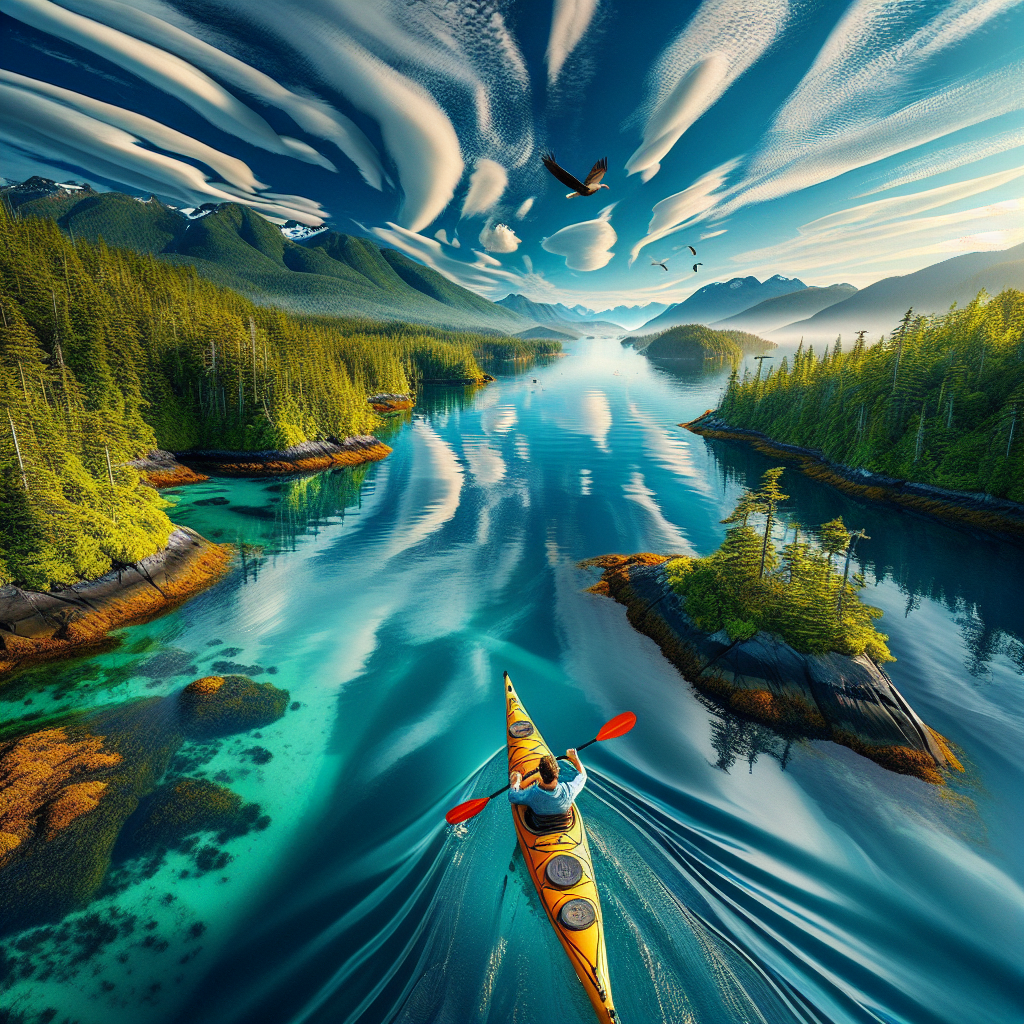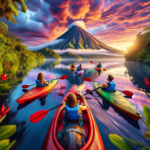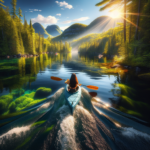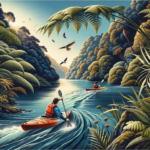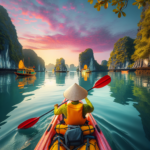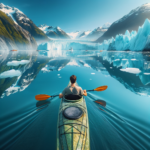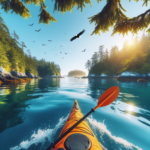Kayaking in Johnstone Strait, British Columbia, Canada
Introduction to Kayaking
Kayaking is a thrilling outdoor activity that has gained immense popularity over the years. It offers a unique way to explore nature, providing an up-close and personal experience with the water and surrounding landscapes. Whether you’re paddling through serene lakes, navigating swift rivers, or exploring coastal waters, kayaking offers a sense of adventure and tranquility that is hard to match. The sport is accessible to people of all skill levels, making it a favorite pastime for both beginners and seasoned paddlers.
In this article, we will spotlight the unique features of kayaking in Johnstone Strait, British Columbia, Canada. This destination is renowned for its stunning natural beauty, diverse wildlife, and excellent kayaking conditions. We’ll delve into what makes Johnstone Strait a fantastic spot for kayaking enthusiasts, from its geographical features to the best times to visit. Whether you’re planning your first kayaking trip or looking for a new adventure, Johnstone Strait has something to offer.
Johnstone Strait is not just another kayaking destination; it is a place where nature and adventure converge. The strait is known for its rich marine life, including orcas, dolphins, and sea lions, making it a paradise for wildlife enthusiasts. The waters are generally calm, providing a safe and enjoyable experience for kayakers of all levels. Additionally, the area is steeped in cultural history, adding another layer of intrigue to your kayaking adventure.
In the following sections, we will explore the various aspects that make kayaking in Johnstone Strait a unique and unforgettable experience. From the best spots to paddle to safety guidelines and environmental considerations, this comprehensive guide will equip you with all the information you need for a successful kayaking trip in this beautiful part of British Columbia.
Overview of Kayaking in Johnstone Strait, British Columbia, Canada
Johnstone Strait is a narrow passage located between Vancouver Island and the mainland of British Columbia. The strait stretches approximately 110 kilometers and is part of the Inside Passage, a coastal route that extends from the southeastern coast of Alaska to the northwestern coast of Washington State. The geography of Johnstone Strait is characterized by rugged coastlines, dense forests, and numerous islands, making it a picturesque setting for kayaking.
The climate in Johnstone Strait is generally mild, with cool summers and wet winters. The best time to visit for kayaking is during the summer months, from June to September, when the weather is most favorable. During this period, the waters are calmer, and the chances of encountering marine wildlife are higher. The strait’s unique geography and climate create ideal conditions for kayaking, attracting enthusiasts from around the world.
Historically, the waters of Johnstone Strait have been used by Indigenous peoples for transportation and fishing. The area is rich in cultural heritage, with numerous archaeological sites and ancient village locations. Today, kayaking in Johnstone Strait offers a unique opportunity to connect with this history while enjoying the natural beauty of the region. Visitors can access Johnstone Strait via several entry points, including the towns of Telegraph Cove and Port McNeill, both of which offer amenities and services for kayakers.
The best times to visit Johnstone Strait for kayaking are during the summer months when the weather is warm and the waters are calm. This period also coincides with the migration of orcas, providing a unique opportunity to paddle alongside these magnificent creatures. Whether you’re a seasoned kayaker or a beginner, Johnstone Strait offers a range of experiences that cater to all skill levels. From guided tours to solo adventures, there are plenty of options to explore this stunning part of British Columbia.
Kayaking Conditions in Johnstone Strait, British Columbia, Canada
Johnstone Strait is primarily a coastal waterway, making it an ideal location for sea kayaking. The strait’s waters are generally calm, especially during the summer months, providing a safe and enjoyable experience for kayakers. However, it’s essential to be aware of the tidal currents, which can be strong and unpredictable at times. Understanding the tides and planning your trip accordingly can help ensure a smooth and enjoyable kayaking experience.
The weather conditions in Johnstone Strait vary throughout the year. Summers are typically mild and dry, with temperatures ranging from 15 to 25 degrees Celsius. This period offers the best conditions for kayaking, with calm waters and clear skies. In contrast, the winter months are wet and cold, with frequent rain and occasional snow. While kayaking is still possible during this time, it requires more preparation and caution due to the harsher conditions.
Tides and currents play a significant role in the kayaking conditions in Johnstone Strait. The strait experiences semi-diurnal tides, meaning there are two high tides and two low tides each day. The tidal range can be substantial, affecting the water levels and currents. It’s crucial to check the tide charts and plan your trip around the tidal schedule to avoid strong currents and ensure a safe journey. Additionally, wind conditions can impact kayaking, with stronger winds creating choppier waters.
Environmental factors such as water temperature and visibility also influence kayaking conditions in Johnstone Strait. The water temperature remains relatively cold year-round, averaging around 10 degrees Celsius. Wearing appropriate gear, such as a wetsuit or drysuit, is essential to stay warm and comfortable. Visibility in the water can vary, with clearer conditions during the summer months. Being aware of these factors and preparing accordingly will enhance your kayaking experience in Johnstone Strait.
Top Spots for Kayaking in Johnstone Strait, British Columbia, Canada
One of the top spots for kayaking in Johnstone Strait is Robson Bight Ecological Reserve. This area is renowned for its population of orcas, making it a prime location for wildlife enthusiasts. The reserve is a protected area, ensuring the preservation of the natural habitat and providing a unique opportunity to observe these magnificent creatures in their natural environment. The best time to visit Robson Bight is during the summer months when the orcas are most active.
Another popular spot for kayaking in Johnstone Strait is Telegraph Cove. This charming village offers a picturesque setting with its historic buildings and scenic waterfront. Telegraph Cove is an excellent starting point for kayaking adventures, with easy access to the surrounding waters and numerous guided tour options. The area is also known for its diverse marine life, including dolphins, sea lions, and various bird species, providing ample opportunities for wildlife sightings.
Hanson Island is another must-visit location for kayakers in Johnstone Strait. The island is known for its rugged coastline, dense forests, and abundant wildlife. Kayaking around Hanson Island offers a chance to explore hidden coves, secluded beaches, and pristine waters. The island is also home to several camping sites, allowing for multi-day kayaking trips and a more immersive experience in nature. The best time to visit Hanson Island is during the summer months when the weather is most favorable.
For those seeking a more challenging kayaking experience, the Broughton Archipelago is an excellent choice. This group of islands and islets offers a diverse range of paddling conditions, from calm waters to more challenging currents. The archipelago is known for its stunning scenery, with lush forests, rocky shorelines, and crystal-clear waters. Kayaking in the Broughton Archipelago provides a sense of adventure and exploration, with numerous opportunities for wildlife sightings and secluded camping spots.
Safety and Regulations
Safety is paramount when kayaking in Johnstone Strait. Local regulations require all kayakers to wear a personal flotation device (PFD) at all times while on the water. It’s also recommended to carry a whistle or other signaling device to alert others in case of an emergency. Additionally, kayakers should be aware of the local marine traffic and avoid areas with heavy boat traffic to ensure their safety.
It’s essential to be prepared for emergency situations while kayaking in Johnstone Strait. Carrying a first aid kit, a map of the area, and a communication device such as a VHF radio or a mobile phone can be crucial in case of an emergency. Knowing how to perform basic self-rescue techniques and having a plan in place for different scenarios can also enhance your safety on the water. Participating in a kayaking safety course before your trip can provide valuable skills and knowledge.
Weather conditions can change rapidly in Johnstone Strait, so it’s important to check the weather forecast before heading out. Being aware of the tides and currents is also crucial, as these factors can significantly impact your kayaking experience. Planning your trip around the tidal schedule and avoiding strong currents can help ensure a safe and enjoyable journey. Additionally, it’s recommended to paddle with a group or a partner for added safety and support.
Respecting the local environment and wildlife is also an essential aspect of kayaking in Johnstone Strait. Following Leave No Trace principles, such as packing out all trash and minimizing your impact on the natural surroundings, helps preserve the area’s beauty and ecological integrity. Observing wildlife from a safe distance and avoiding disturbing their natural behaviors ensures a positive experience for both kayakers and the animals that inhabit the region.
Amenities and Accommodations
Johnstone Strait offers a range of amenities to enhance your kayaking experience. Several rental facilities in the area provide kayaks, paddles, and safety gear for visitors. Guided tours are also available, offering expert knowledge and insights into the local environment and wildlife. These tours can be an excellent option for beginners or those looking to learn more about the area while enjoying a safe and guided kayaking experience.
Accommodation options in Johnstone Strait cater to various preferences and budgets. For those who enjoy camping, there are several campgrounds and designated camping sites on the islands and along the coastline. These sites offer a more immersive experience in nature, allowing you to wake up to the sounds of the ocean and enjoy the serenity of the surroundings. Some campgrounds also provide basic amenities such as restrooms and picnic areas.
If you prefer more comfortable accommodations, there are several hotels, lodges, and bed-and-breakfast options in nearby towns such as Telegraph Cove and Port McNeill. These establishments offer a range of amenities, including dining options, Wi-Fi, and comfortable rooms. Staying in these towns also provides easy access to local attractions, shops, and services, making it convenient for planning your kayaking adventures.
In addition to kayaking, Johnstone Strait offers various recreational activities for visitors to enjoy. Hiking trails, wildlife viewing tours, and fishing opportunities are available for those looking to explore the area further. The region’s rich cultural heritage also provides opportunities to learn about the history and traditions of the Indigenous peoples who have called this area home for thousands of years. Whether you’re kayaking or exploring on land, Johnstone Strait offers a diverse range of activities to make your visit memorable.
Environmental Considerations
Preserving the natural habitats and wildlife of Johnstone Strait is of utmost importance. Kayakers are encouraged to follow eco-friendly practices to minimize their impact on the environment. This includes avoiding disturbing wildlife, staying on designated trails and campsites, and packing out all trash. Using biodegradable soap and minimizing the use of single-use plastics can also help reduce your environmental footprint while kayaking in Johnstone Strait.
Several conservation efforts and local projects are in place to protect the unique ecosystems of Johnstone Strait. Organizations such as the Marine Education and Research Society (MERS) work to study and conserve marine life in the area, including orcas and other cetaceans. Supporting these organizations through donations or volunteering can contribute to the ongoing efforts to preserve the natural beauty and biodiversity of Johnstone Strait.
Kayakers can also participate in citizen science projects while exploring Johnstone Strait. These projects involve collecting data on marine life, water quality, and other environmental factors to support scientific research and conservation efforts. Participating in these initiatives not only enhances your kayaking experience but also contributes to the broader understanding and protection of the region’s ecosystems.
Educating yourself about the local environment and wildlife before your trip can also help you make informed and responsible choices while kayaking in Johnstone Strait. Understanding the behaviors and needs of the animals you may encounter allows you to observe them respectfully and minimize any potential disturbances. By practicing responsible and eco-friendly kayaking, you can help ensure that Johnstone Strait remains a pristine and vibrant destination for future generations to enjoy.
Highlights
When comparing Johnstone Strait to other popular kayaking destinations, several unique features stand out. The strait’s rich biodiversity, including its population of orcas, dolphins, and sea lions, sets it apart as a prime location for wildlife enthusiasts. The opportunity to paddle alongside these magnificent creatures in their natural habitat is a highlight that few other destinations can offer. Additionally, the strait’s calm waters and stunning scenery make it an ideal spot for both beginners and experienced kayakers.
Geographically, Johnstone Strait offers a diverse range of landscapes, from rugged coastlines and dense forests to secluded beaches and hidden coves. This variety provides kayakers with numerous opportunities for exploration and adventure. The strait’s location within the Inside Passage also adds to its appeal, as it is part of a renowned coastal route that attracts kayakers from around the world. The combination of natural beauty and accessibility makes Johnstone Strait a standout destination.
Historically, Johnstone Strait holds significant cultural importance. The waters have been used by Indigenous peoples for thousands of years, and the area is rich in archaeological sites and ancient village locations. This cultural heritage adds another layer of intrigue to your kayaking experience, allowing you to connect with the history and traditions of the region. Exploring Johnstone Strait offers a unique blend of natural beauty and cultural significance that few other destinations can match.
Data-driven analysis also highlights the favorable kayaking conditions in Johnstone Strait. The mild climate, calm waters, and predictable tidal patterns create an ideal environment for kayaking. The strait’s accessibility and range of amenities further enhance its appeal, making it a convenient and enjoyable destination for kayakers of all levels. Whether you’re seeking a peaceful paddle or an adventurous exploration, Johnstone Strait offers a unique and unforgettable kayaking experience.
FAQ Section
- What is the best season to go kayaking in Johnstone Strait? The best season for kayaking in Johnstone Strait is during the summer months, from June to September, when the weather is most favorable and marine wildlife is most active.
- Are there beginner-friendly spots for kayaking in Johnstone Strait? Yes, there are several beginner-friendly spots in Johnstone Strait, including Telegraph Cove and Hanson Island, which offer calm waters and guided tour options.
- What should I bring for a kayaking trip in Johnstone Strait? Essential items include a personal flotation device (PFD), paddle, appropriate clothing (wetsuit or drysuit), first aid kit, map, communication device, and eco-friendly supplies.
- Are kayak rentals available in Johnstone Strait? Yes, several rental facilities in the area provide kayaks, paddles, and safety gear for visitors.
- How can I participate in local conservation efforts? You can support local conservation efforts by donating to organizations like the Marine Education and Research Society (MERS) or participating in citizen science projects.
- Are guided kayaking tours available? Yes, guided tours are available and offer expert knowledge and insights into the local environment and wildlife.
- What safety measures should I take while kayaking in Johnstone Strait? Always wear a PFD, carry a whistle or signaling device, check weather and tide conditions, paddle with a group or partner, and follow local regulations.
Final Thoughts
Kayaking in Johnstone Strait, British Columbia, Canada, is a premier destination for kayaking enthusiasts. The combination of stunning natural beauty, diverse wildlife, and excellent kayaking conditions makes it a must-visit location. Whether you’re paddling alongside orcas, exploring hidden coves, or connecting with the region’s rich cultural heritage, Johnstone Strait offers a unique and unforgettable experience.
Respecting local guidelines and conservation efforts is crucial to preserving the natural habitats and wildlife of Johnstone Strait. By practicing responsible and eco-friendly kayaking, you can help ensure that this beautiful destination remains pristine for future generations. Supporting local conservation organizations and participating in citizen science projects further contributes to the protection of the region’s ecosystems.
In conclusion, Johnstone Strait offers a unique blend of adventure, natural beauty, and cultural significance that few other kayaking destinations can match. Whether you’re a seasoned kayaker or a beginner, the strait provides a range of experiences that cater to all skill levels. We invite you to explore the beauty and thrill of kayaking in Johnstone Strait, British Columbia, Canada, and create memories that will last a lifetime.

